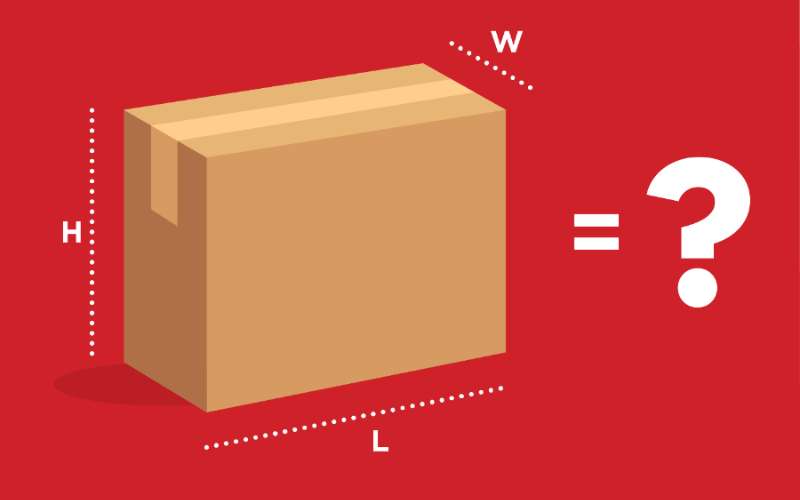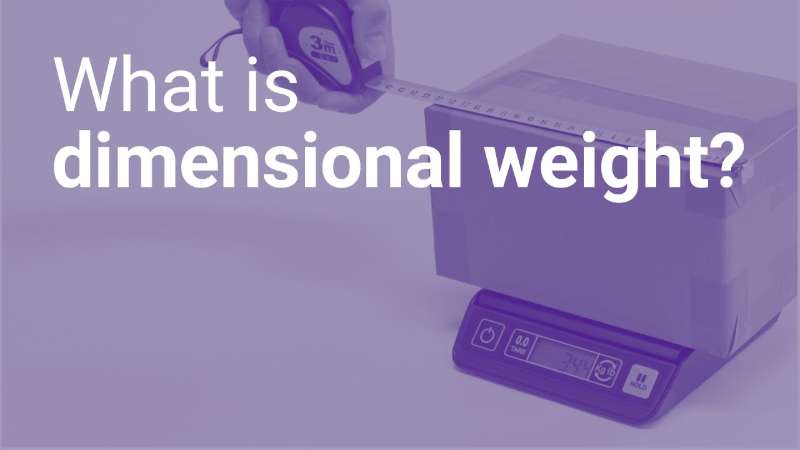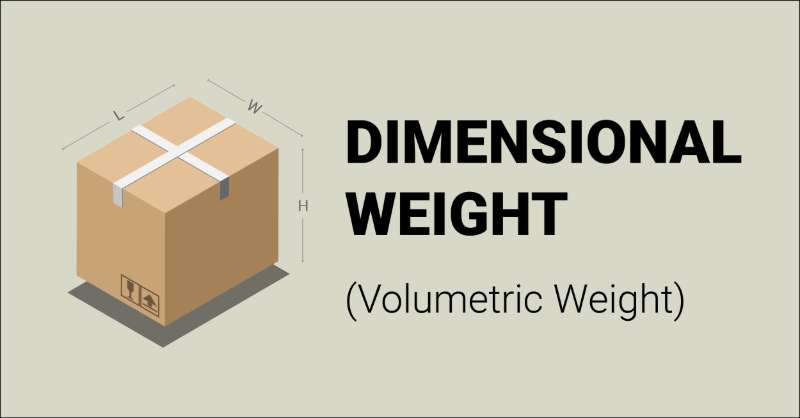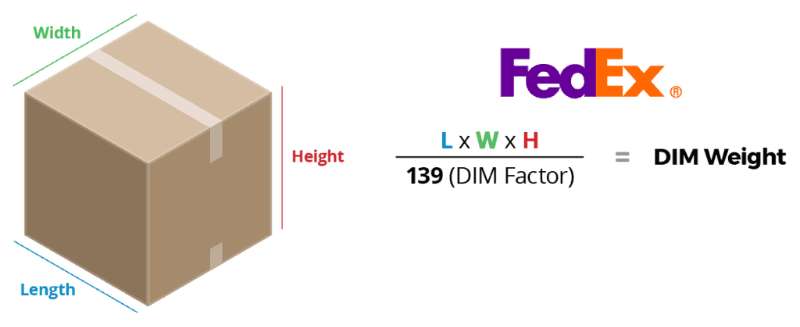You must have come across the term “dimensional weight” when shipping your packages. What is this? How to calculate it? The basics of this metric system are essential as it is common in shipping.
As a sourcing expert for over a decade, we have helped companies with local and global shipments. Therefore, we know what dimensional weight is and how it affects your business. You can minimize your shipping costs with the advice of our fulfillment expert.
So, we’ll be introducing dimensional weight. Let’s get started!

- Definition of dimensional weight
- What is the reason why dimensional weight is essential?
- Dimensional weight Pricing
- How to calculate dimensional weight?
- How do you help clients reduce dimensional weight charges?
- How do FedEx, UPS, and USPS calculate dimensional weight?
- FAQs about Dimensional Weight
- What’s Next
Definition of dimensional weight

Dimensional weight is a pricing technique for commercial freight transportation. It is commonly called DIM weight, which includes courier and postal services. We will multiply the length, width, and height to calculate the dimensional weight.
Dimensional weight considers package density as the delivery truck’s space is constrained. Hence, it’s worthwhile to compute DIM weight even if your package is lightweight.
Remember that DIM weight is solely dependent on volume and not actual weight. By applying a factor, you can convert the actual volume in cubic inches to a theoretical weight in pounds.
You need to look at two numbers: the actual package weight or its computed dimensional weight. Whichever is greater determines your shipping prices. Your billable weight is ascertained by which value is higher.
What is the reason why dimensional weight is essential?
Dimensional weight calculates charges based on the space a package occupies.
You could ship enough air-filled bags to fill an entire truckload and only pay a few dollars. The weight would be so low if pricing depended only on total weight. DIM weight calculates more realistic expenses of transporting a complete truckload. It is especially for trucks that contain lightweight items.
The growth of e-commerce influenced the development of DIM weight. It took up a lot of space on trucks and vans each day to deliver many more products to many more houses. Ecommerce packages often have a single item packed in a large box. They might contain lots of light padding like bubble wrap, brown paper, and air-filled bags. Comparing that to a pallet of products moved between warehouses is entirely different.
Dimensional weight Pricing

You can run the calculation for a sample of your packages. It will show you if the dimensional weight impacts your shipping expenses.
Calculate the DIM weight by measuring and weighing a package. The DIM weight or the actual weight, whichever is greater, will be used by your carrier.
Let’s say your DIM weight is 31 pounds.
Assume the package’s actual weight is 29 pounds. Then, the freight company will charge for the greater dimensional weight of 31 pounds.
On the other hand, assume the real weight of the package is 33 pounds. Then, dimensional weight pricing will follow the actual weight, not the dimensional weight.
Dimensional weight may affect your business if your sample packages have a greater DIM weight than the actual weight.
How to calculate dimensional weight?

1. Measure the parcels.
Use the longest point on each side of the package to measure its length, width, and height. Abnormalities not considered in the initial calculations for dimensional weight may result in additional handling costs. These measurements should account for any bulges or oddly shaped sides.
2. Round up the numbers.
The shipping carrier will ask you to round up your DIM weight calculation to the nearest whole number.
3. Calculate dimensional weight.
After that, multiply those package measurements to determine the package’s cubic size. For instance, if your package size is 30 inches by 12 inches by 14 inches, the product of these three measurements multiplied results in 5,040 cubic inches. You can also try using dimensional weight calculators.
4. Divide the DIM weight by the factor.
The package’s cubic size is then divided by a dimensional factor, also referred to as a dimensional weight divisor. The biggest freight carriers, like UPS and FedEx, set their own DIM divisors. These variables represent inches per pound.
A Fast , Easy and Cheap Way to Ship from China
Do not hesitate to contact Leeline Sourcing at any time regarding your shipments from China.
How do you help clients reduce dimensional weight charges?
Your sales don’t have to suffer because of dimensional weight, even if your products are enormous or need additional packing. Working with a company like ours that specializes in order fulfillment can help you reduce shipping costs.
Order fulfillment businesses use the leading freight carriers to ship many products. Hence, we can negotiate bulk rates and pass the savings to you. In addition to dealing with a reduced fee per pound transported, we can minimize your shipping charges by negotiating more favorable DIM factors.
Our fulfillment team uses effective packing materials to enhance space usage and lower delivery costs. If required, we will even repackage a product from its original box with your agreement. It further reduces dimensional weight and lowers the shipping cost. Savings mount up!
How do FedEx, UPS, and USPS calculate dimensional weight?
1. FedEx

In 2017, FedEx modified its dimensional factor from 166 to 139.
For example, the billable weight of a 10″ x 10″ x 10″ package is (10 x 10 x 10)/139 = 8 pounds. So, your FedEx shipping costs would be calculated using the volumetric weight.
Zones 5 through 8 are often slightly cheaper for FedEx.
2. UPS

For shippers who pay retail rates, UPS has a DIM Factor of 166. The lower 139 is the DIM factor for daily rates.
For the retail rate, a 6-pound product measuring 10″ x 10″ x 10″ would have a DIM weight of (10 x 10 x 10)/166 = 7 pounds.
When shipping at the daily rates, the DIM weight is increased to 8 pounds.
Therefore, UPS retail rates result in a lower billed weight.
3. USPS
USPS reduced their dimensional factor to 166.
USPS still has a lower surcharge than UPS or FedEx. For instance, FedEx and UPS’ daily rates would charge 15 pounds for a 12″ x 12″ x 14″ package. For USPS, it was only 13 pounds.
Even items impacted by dimensional weight may not cost extra when shipping with USPS Priority Mail. Therefore, it shouldn’t be a problem for domestic shipments.
FAQs about Dimensional Weight
1. What is DIM Factor?
The DIM factor is a figure that freight carriers utilize to determine the dimensional weight of a package. You must divide the volume by the DIM factor to obtain the DIM weight. A higher DIM factor means lower cost.
Each freight carrier determines its own DIM factor, changing it yearly.
2. What are the methods to right-size your packaging and save?
See if you can safely fit your product in smaller boxes. When possible, maximize space utilization. For example, if you switch to thinner fillers, your product can fit in a smaller box with reduced package dimensions.
3. How does dimensional weight affect package prices?
If your package is heavy and small, the shipping cost will likely be determined by the actual weight.
However, the charges will be based on the dimensional weight if it is higher than the actual weight. Hence, dimensional weight pricing will negatively impact large but lightweight packages.
What’s Next
We’ve shared important information about dimensional weight calculations. In addition, you can find the DIM weight pricing of various logistics companies for your reference. Besides, follow the tricks on enhancing space utilization to reduce package volume and shipping costs.
Need advice on international shipping? Leeline Sourcing has over a decade of international business experience. Contact us today to discover further about the delivery methods you need!








